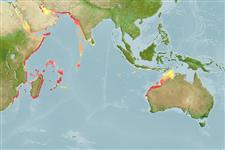>
Syngnathiformes (Pipefishes and seahorses) >
Syngnathidae (Pipefishes and seahorses) > Nerophinae
Etymology: Dunckerocampus: From Duncker, an ichthyologist and taxonomist that recognized four Gobiidae families (1928) + Gr, kampe = bent; boylei: Named for Bill Boyle, an underwater fish photographer who brought the species to the attention of the author..
Environment: milieu / climate zone / depth range / distribution range
Ekologi
marina bottenlevande; ej vandrande; djupintervall 20 - 95 m (Ref. 31080). Deep-water
Indian Ocean: Red Sea, Mauritius and Tulamben, north coast of Bali, Indonesia. Expected to be wide ranging in the Indian Ocean and adjacent waters.
Size / Vikt / Age
Maturity: Lm ? range ? - ? cm
Max length : 16.0 cm TL hane/ej könsbestämd; (Ref. 48635)
Short description
Morfologi | Morfometri
Mjukstrålar i ryggfenan (totalt): 21; Mjukstrålar i analfenan: 4. Broader bands and diagnostic caudal fin pattern (Ref. 48635).
Adults prefer depths of about 25 m or more and is easily overlooked (Ref. 48635). Ovoviviparous (Ref. 205). The male carries the eggs in a brood pouch which is found under the tail (Ref. 205). Solitary or in pairs in caves and crevices (Ref 90102).
Life cycle and mating behavior
Könsmognad | Reproduktion | Lek | Ägg | Fecundity | Larver
Male carries the eggs in a brood pouch (Ref. 205).
Kuiter, R.H., 1998. Pipefishes of the syngnathid genus Dunckerocampus (Sygnathiformes: Sygnathidae), with a description of a new species from the Indian Ocean. aqua, J. Ichthyol. Aquat. Biol. 3(2):81-84. (Ref. 31080)
IUCN Red List Status (Ref. 130435)
Threat to humans
Harmless
Human uses
Fiskeri: saknar intresse
Ytterligare information
Age/SizeTillväxtLength-weightLength-lengthLength-frequenciesMorfometriMorfologiLarverLarvdynamikRekryteringAbundansBRUVS
referenserVattenbrukVattenbruksprofilAvelslinjerGenetikElectrophoresesÄrftlighetSjukdomarBehandlingNutrientsMass conversion
MedarbetareBilderStamps, Coins Misc.LjudCiguateraHastighetSimsättGälytaOtolithsHjärnstorlekSyn
Verktyg
Special reports
Download XML
Internet-källor
Estimates based on models
Preferred temperature (Ref.
123201): 23.7 - 27.8, mean 26.1 °C (based on 42 cells).
Phylogenetic diversity index (Ref.
82804): PD
50 = 0.5078 [Uniqueness, from 0.5 = low to 2.0 = high].
Bayesian length-weight: a=0.00085 (0.00032 - 0.00224), b=3.04 (2.81 - 3.27), in cm total length, based on LWR estimates for this (Sub)family-body shape (Ref.
93245).
Trofisk nivå (Ref.
69278): 3.7 ±0.6 se; based on size and trophs of closest relatives
Resiliens (Ref.
120179): Hög, lägsta populationsfördubblingstid mindre än 15 månader (Preliminary K or Fecundity.).
Fishing Vulnerability (Ref.
59153): Low vulnerability (10 of 100).
